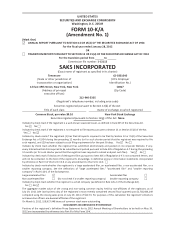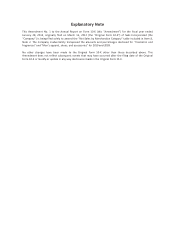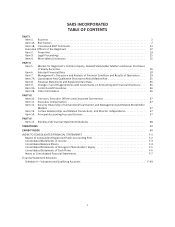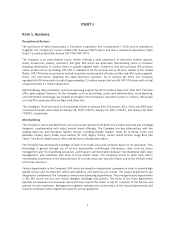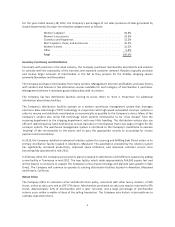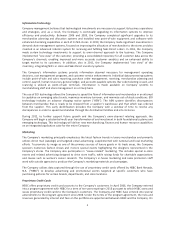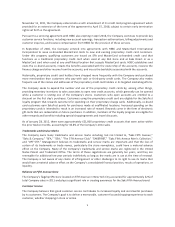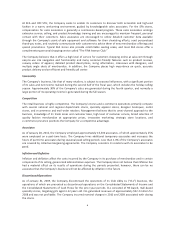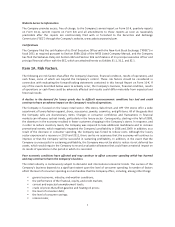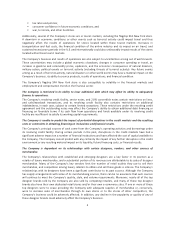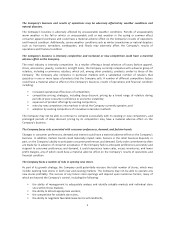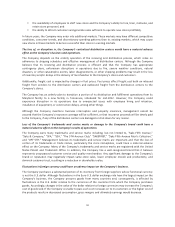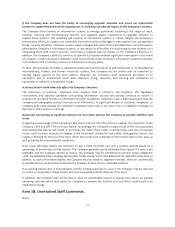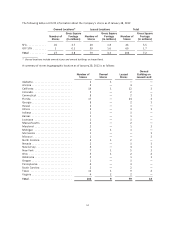Saks Fifth Avenue 2011 Annual Report Download - page 6
Download and view the complete annual report
Please find page 6 of the 2011 Saks Fifth Avenue annual report below. You can navigate through the pages in the report by either clicking on the pages listed below, or by using the keyword search tool below to find specific information within the annual report.Information Technology
Company management believes that technological investments are necessary to support its business operations
and strategies, and, as a result, the Company is continually upgrading its information systems to improve
efficiency and productivity. Between 2006 and 2009, the Company completed significant upgrades to its
merchandise planning and allocation systems and installed new point-of-sale equipment and software with
enhanced clienteling capabilities in each of its SFA stores. In 2010, the Company made significant investments in
demand chain management systems, focused on improving the allocation of merchandise to the stores and also
invested in an advanced robotics system for receiving and fulfilling Saks Direct orders. In 2011, the Company
made certain technology investments to support its omni-channel approach to the business. The Company
implemented “one view” of the customer, providing a consolidated repository for all customer data across the
Company’s channels, enabling improved and more accurate customer analytics and an enhanced ability to
target market to its customers. In addition, also in 2011, the Company implemented “one view” of the
inventory, integrating SFA’s in store and Saks Direct inventory systems.
The Company’s information systems provide information deemed necessary for management operating
decisions, cost management programs, and customer service enhancements. Individual data processing systems
include point-of-sale and sales reporting, purchase order management, receiving, merchandise planning and
control, payroll, human resources, general ledger, and accounts payable systems. Bar code ticketing is used, and
scanning is utilized at point-of-sale terminals. Information is made available on Company systems to
merchandising staff and store management on a timely basis.
The use of EDI technology allows the Company to speed the flow of information and merchandise in an attempt
to capitalize on emerging sales trends, maximize inventory turnover, and minimize out-of-stock conditions. EDI
technology includes an advance shipping notice system (“ASN”). The ASN system identifies discrepancies
between merchandise that is ready to be shipped from a supplier’s warehouse and that which was ordered
from the supplier. This early identification provides the Company with a window of time to resolve any
discrepancies in order to speed merchandise through the distribution facilities and into its stores.
During 2012, to further support future growth and the Company’s omni-channel retailing approach, the
Company will begin a substantial multi-year transformation of and investment in both foundational systems and
emerging technology. This technology will deliver new merchandising, finance and human resource capabilities
on an integrated application suite for the entire Company.
Marketing
The Company’s marketing principally emphasizes the latest fashion trends in luxury merchandise and primarily
utilizes direct mail (catalogs) and targeted email advertising, supplemented with national and local marketing
efforts. To promote its image as one of the primary sources of luxury goods in its trade areas, the Company
sponsors numerous fashion shows and in-store special events highlighting the designers represented in the
Company’s stores. The Company also participates in “cause-related” marketing. This includes special in-store
events and related advertising designed to drive store traffic, while raising funds for charitable organizations
and causes such as women’s cancer research. The Company’s in-house marketing and sales promotion staff
work with outside agencies to produce the Company’s marketing materials and campaigns.
The Company utilizes data captured through the use of proprietary credit cards offered by HSBC Bank Nevada,
N.A. (“HSBC”) to develop advertising and promotional events targeted at specific customers who have
purchasing patterns for certain brands, departments, and store locations.
Proprietary Credit Cards
HSBC offers proprietary credit card accounts to the Company’s customers. In April 2003, the Company entered
into a program agreement with HSBC for a term of ten years expiring in 2013 pursuant to which HSBC owns and
issues proprietary credit cards to the Company’s customers. The Company and HSBC have entered into several
amendments to the program agreement since 2003. Under the terms of the program agreement, the risks and
revenues generated by interest and fees on the portfolio are apportioned between HSBC and the Company. On
4

